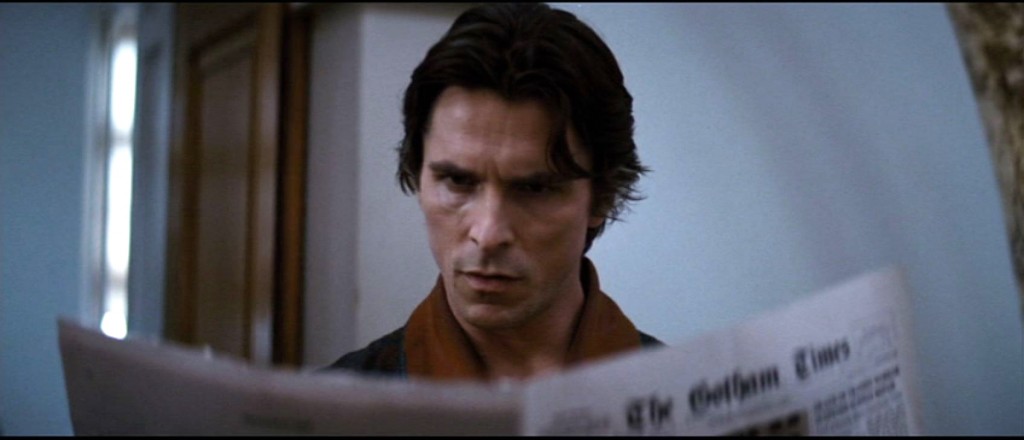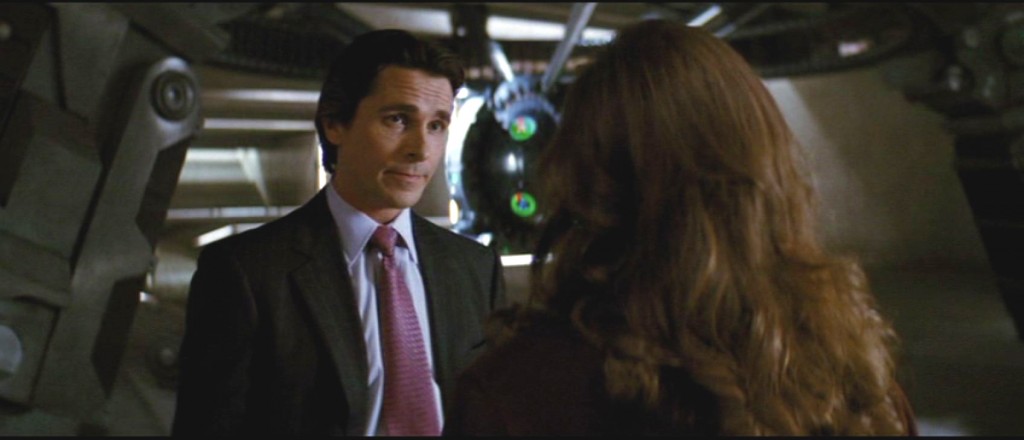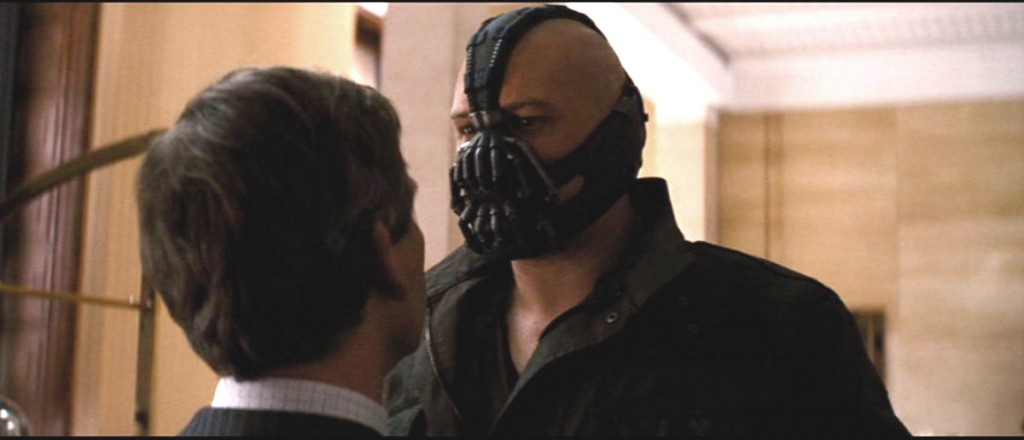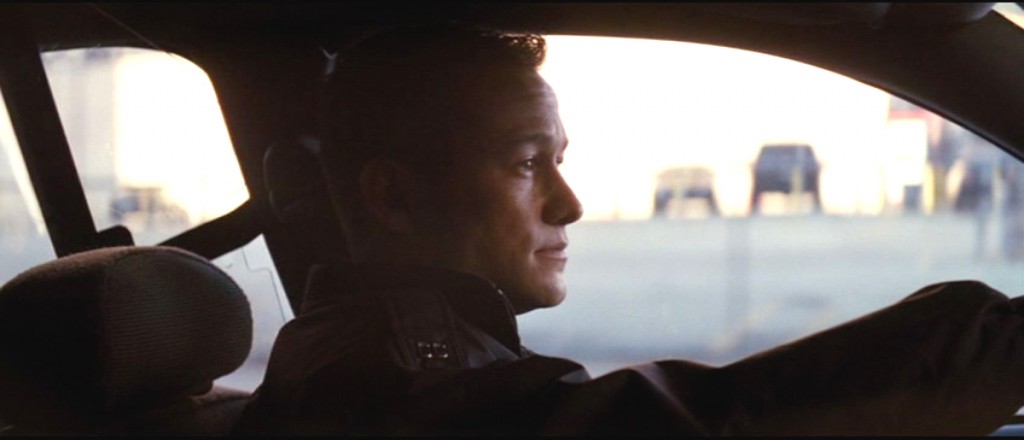Batman: The Dark Knight Rises part 7
Lucius Fox comes to Bruce’s now-Alfredless house to deliver the bad news: Bane’s hit on the stock exchange, where he used Bruce’s Selina-stolen thumbprint to approve some very bad stock buys, has left Bruce broke. (Comics readers know that Bane, historically, “broke” Batman physically — his punishment for Bruce Wayne is more fitting. You break Batman physically, you break a billionaire financially.) (Note that “billionaire playboy” is no longer Bruce’s job description, but rather “billionaire recluse.”) Broke Bruce means that John Daggett can now take over Wayne Enterprises, which means that he has control over the “save the world” project, unless Bruce can put seeming good-guy Miranda Tate in charge of the company.
So Bruce shows Miranda the “save the world” project, which is some stripe of fusion reactor, which, at 62 minutes into the narrative, becomes the maguffin. Bruce mothballed the reactor because Dr. Pavel, who we saw get kidnapped by Bane back at the top of the movie, knows how to turn a fusion reactor into a nuclear bomb. I’ve said before that all superhero stories are power fantasies, but Rises doubles the action in a way not even other Batman stories do, by underlining how Bruce Wayne, all by himself, is an incredible force for change. Just like Alfred argues, Bruce doesn’t need Batman to exert incredible control over Gotham City. He can give the city limitless green energy (shades of Tony Stark) or he can hide his toys in a cave (as he does with both his reactor and his Batsuit). (It’s probably too much to say that the maguffin, as well as the protagonist, is a reactor.) The fact that the maguffin can both hugely benefit a city or utterly destroy it underlines its relationship not just to the Bruce/Bane dyad, but to the dual nature of Bruce himself, and all he represents: the super-wealthy can apply their power any way they want to. A billionaire can cure malaria like Bill Gates, create a media empire like Ted Turner, make himself a public laughingstock like Donald Trump, or start a war for profit like William Randolph Hearst. That is the essence of power. Bruce, in Act I of Rises, withheld his power and has shrunk dramatically because of it. His inaction gave John Daggett the opportunity to act (and Daggett is nothing if not an opportunist), showing that even when a billionaire does nothing it still exerts tremendous power in a society.
Bruce abdicates his position at Wayne Enterprises and comes downstairs to find his car being towed. It’s hard to believe that Bruce Wayne wouldn’t be able to buy a car with cash, and it’s even harder to believe that the car company would get their repo men out so quickly, and it’s harder still to believe that Bruce Wayne doesn’t even have a savings account separate from his business accounts, but again, these are the narrative choices that come with having a man dress up like a bat: in order to show an exertion of power on the cinematic level of a punch to the face or a motorcycle chase through the streets of the city, a movie has to play fast and loose with logic. We need to feel the immediacy of Bruce’s peril, that the loss of his money has as much oomph as, say, being drugged, set on fire and thrown out the window by the Scarecrow in Begins. (The reason those moments ring false to us is that everyone knows that people as wealthy as Bruce Wayne never really need to suffer the embarrassments of poverty, they will always have a cushion to their fall, no matter how steep.)
Daggett is livid now, and goes home to yell at Bane about how his plan to take over Wayne Enterprises has failed. He has forgotten, for the moment, that Bane is a gigantic monster with a hideous mask on his face, and Bane quickly reminds him, snapping his neck like the proverbial twig. The real problem, of course, is not Bane’s appearance but his belief system: Daggett is a businessman, but Bane is a true believer. The businessman will lie, cheat, steal and kill for profit, but the true believer will sacrifice everything for a goal. Oddly enough, the Daggett/Bane dichotomy has a component in real life: many people forget that, in addition to being a cave-dwelling terrorist, Osama bin Laden was also a billionaire, from a family of billionaires, doing battle in the mideast against other billionaires (in the Arab world) and the billionaire-from-a-billionaire-family leader of another country (that would be George W. Bush). The War Against Terror was, in many ways, a private argument between billionaires who had all done business with one another in the past. The problem of Bush being exactly the problem of Daggett: Bush was a businessman, willing to lie, cheat, steal and kill for profit, but bin Laden didn’t care about money, which is what always gives the true believer the edge in battle.
Across town, Bruce gets a ride home from John Blake. That is, Bruce, the loner with the one-man privately-owned Batmobile, now gets a ride from future-Robin in his publicly-owned Robinmobile. Bruce lets Blake into his world a tiny bit, explaining the concept of Batman and the importance of being alone when acting that role (with the butler, the inventor, several people in the district-attorney’s office, the billions of dollars and the tacit support of the entire GCPD). He stops off to see Selina and offers (on behalf of Batman — whether or not Selina has guessed Bruce’s identity at this point depends on how stupid you think she is) her the “clean slate” program she was seeking from Daggett, in exchange for Selina leading Batman to Bane.
Blake, Daytime Robin, goes to see Gordon in the hospital. Gordon is being visited by the idiot Foley, who, whatever he’s doing these days, is not police work. Blake has both found Daggett’s body and the bundles of construction permits Daggett had filed with the city for work in the sewers, tying Daggett to Bane. (The sewers tie Bane to Jean Valjean, but also to the Penguin of Batman Returns, who used his position in Gotham’s underground to collect Gotham’s secrets. Both the Penguin and Bane want to pull Gotham down to their level.) Blake and Gordon understand the importance of a masked man engaging in theatrical crimes, while Foley, ever unprepared for doing Gordon’s job (he’s an anti-Gordon, which makes him also an anti-Alfred) wants whatever is the worst decision imaginable at any given moment. Butting the Daggett/Bane scene against the Gordon/Foley/Blake scene underscores the strengths of all three dominant characters: Daggett huffs and puffs at Bane, who blithely snaps his neck, while Foley huffs and puffs at Blake, while he and Gordon understand in a glance that power does not, in and of itself, make one powerful.




The car being towed is a comic touch, but the one I find more striking is when Lucius shows up and Bruce has to answer his own door. It’s such a small thing, and yet it’s this vivid marker of his fall from the heights of privilege: he’s used to having somebody to do that kind of thing for him. Which is just unimaginable, to — well, to 99% of America.
And what sells the moment is Lucius’s reaction — he’s mortified that Bruce would have to answer his own door, it makes the news he has to bring him so much more painful.
I look at the photo of Christian Bale with the newspaper and imagine him saying “What’s this? ‘Bane Drains Wayne’s Gains’?”
That shot seemed really odd to me too, I didn’t remember it at all from the movie, it was only when I happened to pause the DVD there that I noticed it.
1) A general question: Do you think the best way to organize characters in a screenplay is by working through their mirroring relationships–that is, who is a double, who is an opposite, who is a double with a difference, etc.? Is this more true of action/superhero movies, where some internal struggle often gets played out externally? Or is this just a side-effect of the movies you’ve been analyzing here (Batman’s cast of daytime/nighttime characters, Tintin’s collection of boy-adventurer-collectors, the family-power dynamics of the Avengers, etc.)?
2) Don’t forget Stryver in those last two scenes:
Daggett and Foley huff, misunderstanding power;
Bane and Gordon understand power–and are both true believers (in their way);
Stryver and Blake have some split allegiance, but make their choice here to follow the true believer.
(Is that right? I saw it twice in the theaters, but not since.)
I don’t know if it’s the best way to organize characters, but it’s crucial to theme, which gives a script an organizing principle.
Those are good observations about Stryver and Blake. I had overlooked Stryver being an analogue to Blake, since he leaves the room for Daggett’s murder. Stryver leaves the room when Blake tells him to while Blake takes initiative and gets yelled at by Foley for being a “hothead.” So it’s about obeisance.
Now that you point out these parallels between Stryver and Blake, their fates become more interesting to note: one literally goes down, the other goes up.
Or “rises” if you will
That Bruce might be Batman doesn’t seem to cross Selina’s mind because she thinks Bruce is a typical rich person, someone who doesn’t really care about other people. This is fleshed out when they are dancing at the charity function. Her surprise to learn Batman’s identity seems to have a big effect on the rest of the plot. And it brings up the question of what kind of effect a similar revelation of Batman’s identity to all of Gotham might have had.
I’m just wondering because Selina seems interested in Batman when he shows up on TV. Maybe Selina has an abiding interest in Bruce, while Catwoman has an abiding interest in Batman.